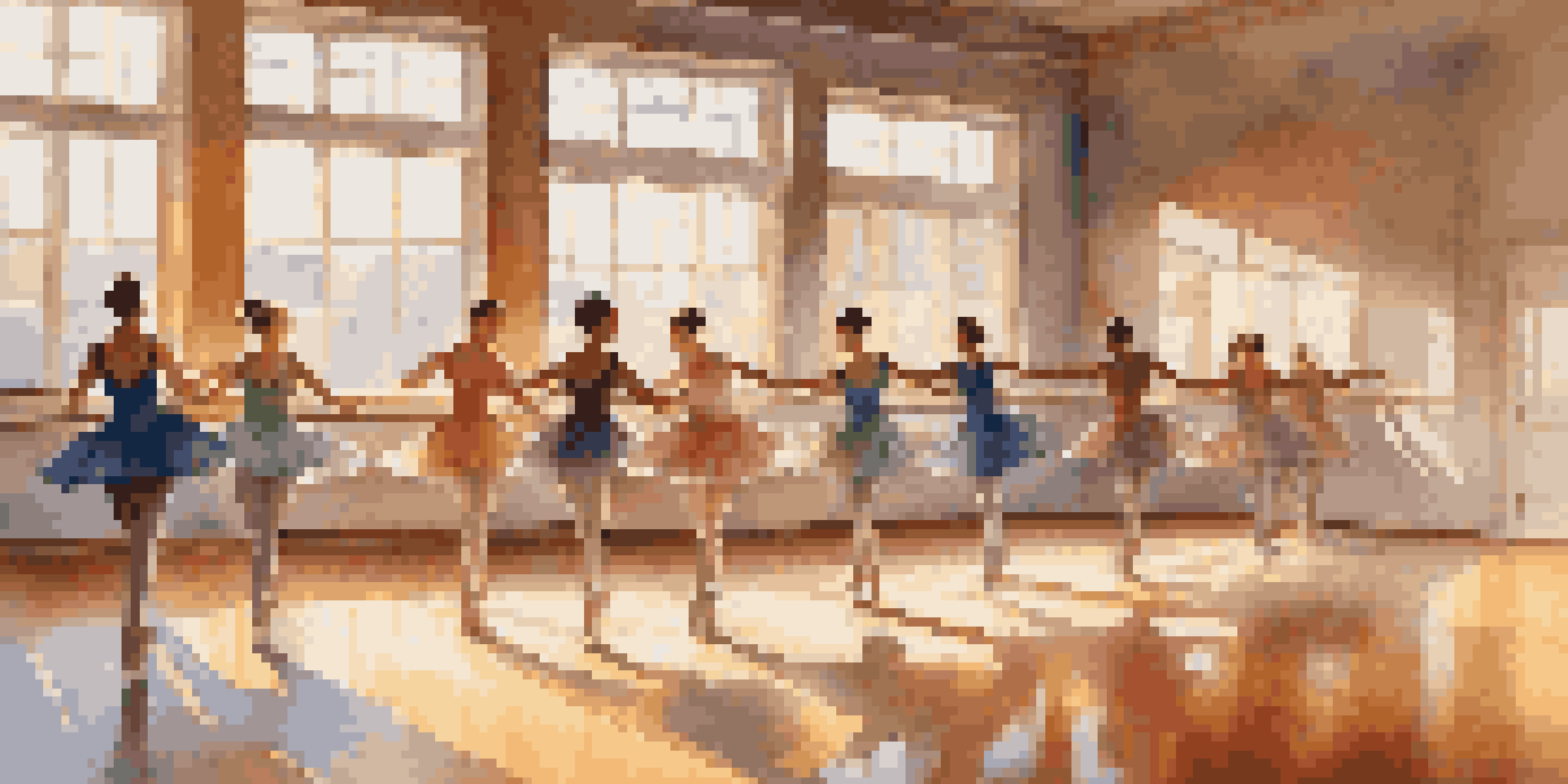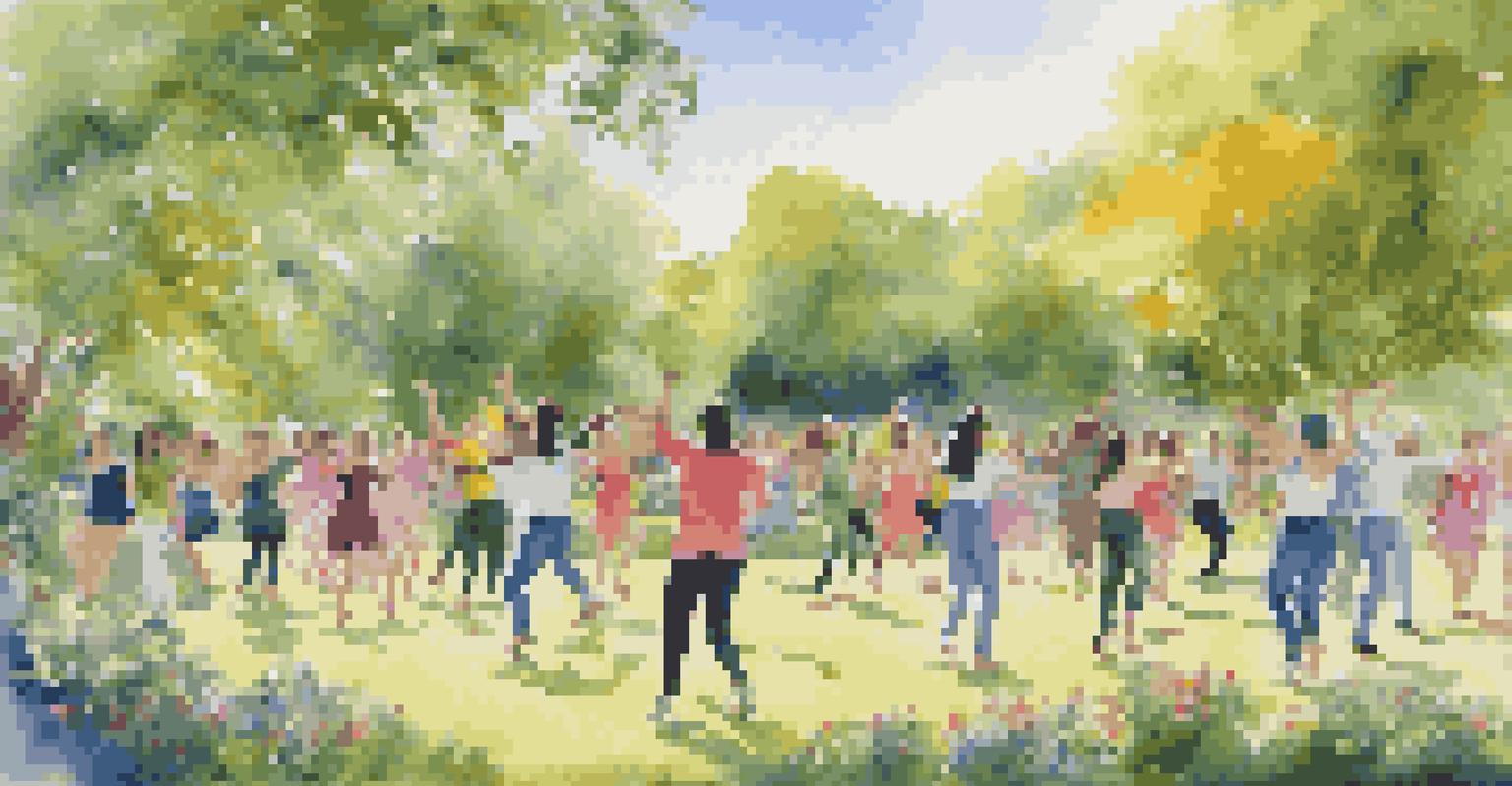The Role of Music in Alleviating Dance Performance Anxiety

Understanding Dance Performance Anxiety
Dance performance anxiety is a common experience among dancers, manifesting as nervousness before a performance. It's that jittery feeling that can make even the most seasoned performers second-guess their abilities. This anxiety can stem from various sources, including fear of judgment, the pressure to succeed, and the desire to impress.
Dance is the hidden language of the soul.
Recognizing this anxiety is the first step towards managing it. Many dancers report feeling a physical response, such as increased heart rate or sweaty palms, which can hinder their performance. Understanding that these feelings are normal can help dancers approach their anxiety with compassion instead of fear.
By addressing performance anxiety, dancers can unlock their full potential and express themselves authentically on stage. The right tools and techniques can pave the way for a more enjoyable and fulfilling performance experience.
The Connection Between Music and Emotion
Music has a powerful ability to evoke emotions, which can be particularly beneficial in dance. Think about how a stirring melody can make you feel joy, sadness, or even nostalgia. This emotional connection to music can serve as a source of comfort for dancers dealing with anxiety, providing a familiar backdrop to their performance.

When dancers listen to music that resonates with them, it can elevate their mood and help them focus on the art of dance rather than the fear of performing. The right playlist can create a safe space, allowing dancers to channel their emotions into their movements instead of being overwhelmed by anxiety.
Dance Anxiety is Common
Many dancers experience performance anxiety, which can stem from fear of judgment and pressure to succeed.
Furthermore, music can serve as an emotional anchor, helping dancers to stay grounded. By aligning their movements with the rhythm and melody, dancers can find a sense of rhythm that calms their nerves and enhances their performance.
Creating the Perfect Pre-Performance Playlist
Curating a pre-performance playlist is an effective strategy for overcoming dance anxiety. This playlist should include songs that inspire confidence and joy, creating a positive mental state before stepping on stage. It's important to choose tracks that resonate personally, as individual preferences can significantly impact mood.
Music can change the world because it can change people.
Consider incorporating a mix of upbeat and calming tracks. Upbeat songs can energize and motivate, while softer melodies can help soothe nerves. Experimenting with different genres and tempos can lead to discovering the perfect combination that sets the right mood for each performance.
Listening to this playlist in the moments leading up to a performance can create a sense of familiarity and comfort. As dancers immerse themselves in the music, they can focus on their movements and let go of distractions, ultimately enhancing their performance.
Music as a Distraction from Performance Anxiety
One of the key benefits of music is its ability to serve as a distraction from anxious thoughts. When dancers focus on the rhythm and melody, they can momentarily escape the mental chatter that often accompanies performance anxiety. This shift in focus can reduce feelings of fear and self-doubt.
Engaging with music can also stimulate the brain's reward system, releasing feel-good hormones like dopamine. This natural high can counteract anxiety by promoting a sense of wellbeing and positivity. Thus, music not only distracts from anxiety but also boosts confidence and motivation.
Music Eases Performance Nerves
Listening to music that resonates with dancers can distract from anxiety and enhance their performance.
Incorporating music into warm-up routines can further enhance this distraction. By allowing the music to guide their movements, dancers can enter a flow state, where anxiety diminishes and performance becomes a joyful expression of creativity.
The Role of Music in Building Confidence
Music can play a pivotal role in building a dancer's confidence. When dancers rehearse with music that they love, they start to associate positive emotions with their movements. This positive reinforcement can gradually diminish anxiety and foster a strong sense of self-assurance.
Additionally, practicing in environments filled with music can simulate performance conditions, helping dancers acclimatize to the experience. The more they rehearse with music, the more confident they become in their ability to perform under pressure.
Ultimately, feeling confident in their connection to the music allows dancers to let go of distractions and embrace their artistry. This confidence translates to the stage, resulting in a more authentic and powerful performance.
Music and Group Dynamics in Dance
In group dance settings, music can enhance the overall dynamic and collaboration among dancers. A shared musical experience can create a sense of unity, fostering camaraderie and support. This mutual connection can alleviate individual performance anxiety by reminding dancers that they are part of a team.
When dancers move together to a common rhythm, they often feel more secure and less isolated in their experiences. The group energy, fueled by the music, can uplift individuals, making the performance feel like a shared celebration rather than a solitary challenge.
Mindfulness Enhances Focus
Incorporating mindfulness with music helps dancers stay present, reducing anxiety and transforming performances into celebrations.
In this supportive environment, dancers can draw strength from one another, allowing them to focus less on their anxiety and more on the collective experience. This shared bond can transform performance anxiety into an exhilarating opportunity for connection and expression.
Incorporating Mindfulness and Music
Mindfulness practices combined with music can significantly help in managing performance anxiety. By being present and fully engaged with the music, dancers can cultivate a sense of calm and focus. This mindfulness approach encourages them to tune into their bodies and the rhythm, allowing anxiety to fade into the background.
Taking a few moments to breathe deeply and connect with the music can ground dancers before they step on stage. This practice can help clear the mind of negative thoughts, replacing them with a focus on movement and expression.

Ultimately, the combination of mindfulness and music creates a powerful tool for dancers. It encourages them to embrace the moment, transforming the performance into a celebration rather than a source of stress.